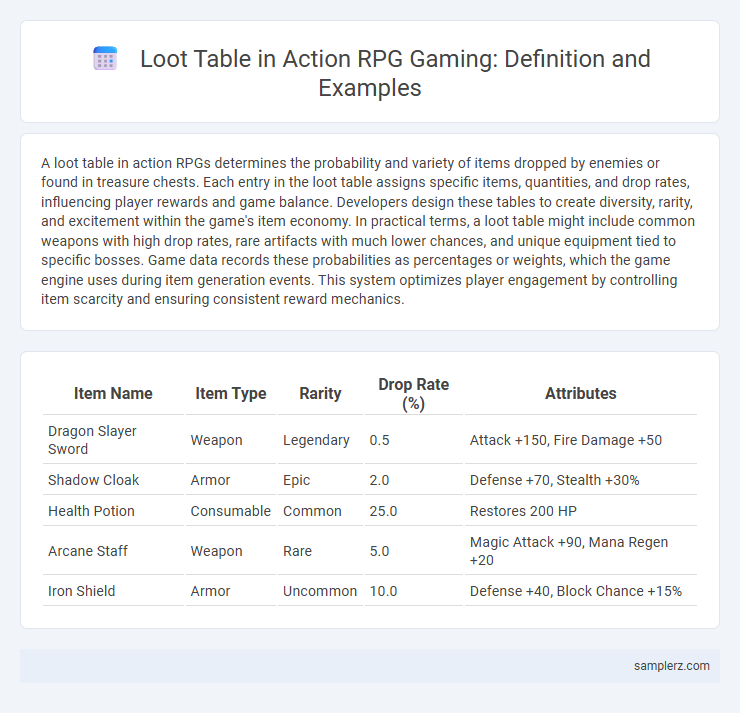A loot table in action RPGs determines the probability and variety of items dropped by enemies or found in treasure chests. Each entry in the loot table assigns specific items, quantities, and drop rates, influencing player rewards and game balance. Developers design these tables to create diversity, rarity, and excitement within the game's item economy. In practical terms, a loot table might include common weapons with high drop rates, rare artifacts with much lower chances, and unique equipment tied to specific bosses. Game data records these probabilities as percentages or weights, which the game engine uses during item generation events. This system optimizes player engagement by controlling item scarcity and ensuring consistent reward mechanics.
Table of Comparison
| Item Name | Item Type | Rarity | Drop Rate (%) | Attributes |
|---|---|---|---|---|
| Dragon Slayer Sword | Weapon | Legendary | 0.5 | Attack +150, Fire Damage +50 |
| Shadow Cloak | Armor | Epic | 2.0 | Defense +70, Stealth +30% |
| Health Potion | Consumable | Common | 25.0 | Restores 200 HP |
| Arcane Staff | Weapon | Rare | 5.0 | Magic Attack +90, Mana Regen +20 |
| Iron Shield | Armor | Uncommon | 10.0 | Defense +40, Block Chance +15% |
Key Components of a Loot Table in Action RPGs
Loot tables in action RPGs feature key components such as item rarity tiers, drop rates, and category filters that govern the distribution of rewards. These tables organize potential drops into common, rare, epic, and legendary groups, each with assigned probabilities influencing gameplay balance and player progression. Dynamic modifiers like player level and enemy difficulty often adjust these rates to maintain challenge and engagement throughout the game.
How Loot Tables Drive Player Progression
Loot tables in action RPGs systematically define the probability and types of items enemies drop, directly influencing player progression by ensuring balanced and rewarding gear acquisition. By dynamically adjusting loot rarity and item attributes, these tables maintain challenge and motivate continuous engagement through meaningful upgrades. This mechanic enables a tailored growth curve where players unlock increasingly powerful equipment aligned with their development stage.
Example: Loot Table for a Dungeon Boss Encounter
A loot table for a dungeon boss encounter in an action RPG typically includes categorized items such as rare weapons, armor pieces, crafting materials, and gold coins with designated drop rates. For example, a dragon boss might drop a legendary sword with a 5% chance, rare dragon scales at 15%, common health potions at 50%, and a sizeable gold reward at 30%. This structured loot distribution enhances player motivation by balancing valuable rewards and frequent consumables to maintain engagement.
Rarity Tiers and Drop Chances in Action RPG Loot Tables
In action RPGs, loot tables are structured with clearly defined rarity tiers such as Common, Uncommon, Rare, Epic, and Legendary, each assigned specific drop chances to balance gameplay and reward players. Common items often have drop rates exceeding 50%, while Rare and Epic items typically fall below 10%, with Legendary drops usually under 1%, creating excitement and value around high-tier loot. Understanding these rarity tiers and their associated probabilities allows players to strategize effectively and enhances the game's replayability.
Customizing Loot Tables for Character Classes
Customizing loot tables in action RPGs enhances gameplay by tailoring rewards to specific character classes, increasing player engagement and strategy. For example, a warrior class might have loot tables favoring heavy armor and melee weapons, while a mage receives magical staffs and spell components. This targeted approach ensures relevant and meaningful drops, optimizing character progression and player satisfaction.
Dynamic Loot Tables: Adapting to Player Levels
Dynamic loot tables in action RPGs adjust item drops based on player levels, ensuring rewards remain challenging and rewarding throughout progression. Higher-level players encounter rarer, more powerful gear while lower-level players receive appropriate equipment that supports their current capabilities. This system enhances player engagement by balancing risk and reward tailored to individual skill and advancement.
Crafting Systems Integrated with Loot Drops
Crafting systems integrated with loot drops in action RPGs rely on dynamic loot tables that generate rare materials, empowering players to create powerful weapons and armor. Items like enchanted ores, mythical essences, and unique crafting blueprints frequently drop from bosses or elite mobs, enhancing the crafting experience. This synergy between loot acquisition and crafting mechanics drives player engagement through meaningful resource collection and equipment customization.
Balancing Challenge and Reward in Loot Distribution
Balancing challenge and reward in loot distribution within action RPGs often involves designing loot tables that scale with player level and difficulty settings, ensuring valuable items remain rare yet attainable. Implementing tiered rarity categories alongside random drop rates allows developers to maintain player engagement by rewarding skill and persistence without trivializing gameplay. Dynamic loot tables that adjust based on player performance and in-game events create a fair but exciting risk-reward system that encourages continuous play and exploration.
Unique Loot Table Features in Popular Action RPGs
Unique loot table features in popular action RPGs include randomized rare item drops with variable affixes, increasing player replayability and strategic inventory management. Games like Diablo III implement a tiered loot table system that dynamically adjusts drop rates based on player level and difficulty settings, enhancing the challenge and reward balance. Borderlands utilizes procedural generation within loot tables to create millions of distinct weapon combinations, driving player excitement through unpredictability and customization options.
Designing Fair and Rewarding Loot Experiences
A well-designed loot table in action RPGs balances rarity and player progression, ensuring drops match the difficulty of encounters while maintaining excitement. Implementing weighted probabilities optimizes item distribution, preventing frustration from repeated low-value rewards. Incorporating dynamic scaling based on player level enhances fairness and sustains engagement through meaningful loot experiences.

example of loot table in action RPG Infographic
 samplerz.com
samplerz.com